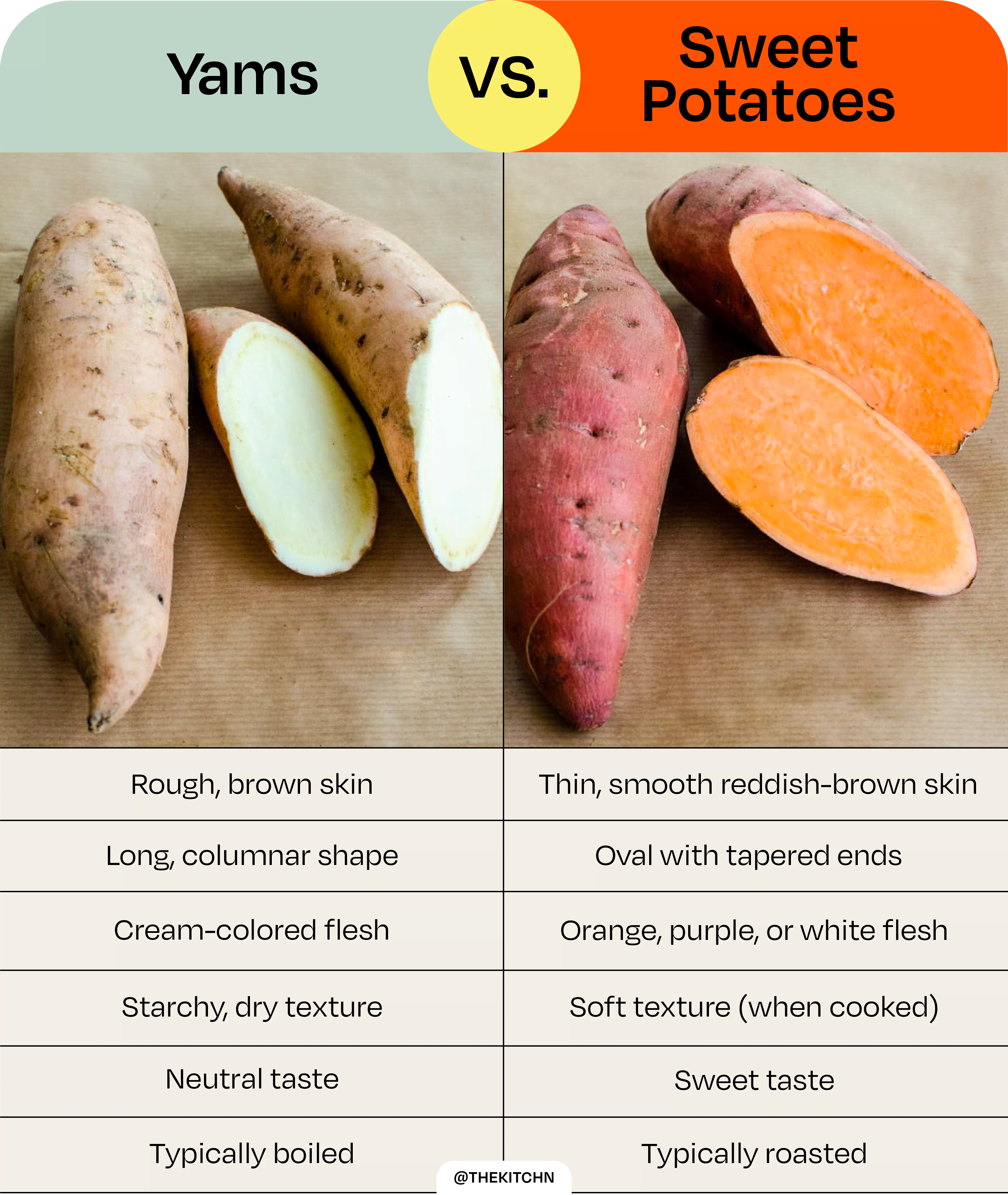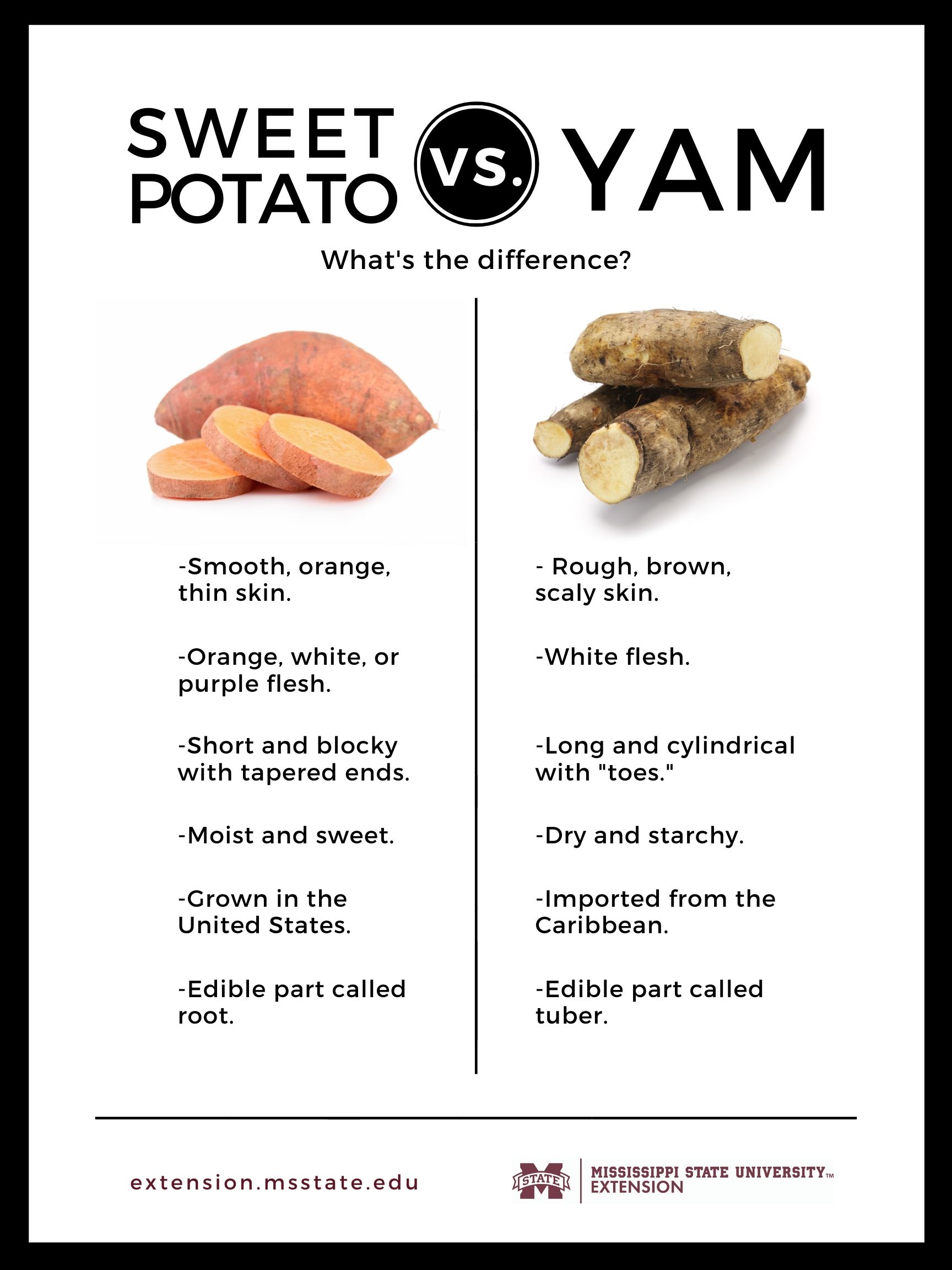In the world of culinary arts, a common misconception has persisted for decades, leading to the widespread confusion between yams and sweet potatoes. These two tubers, often used interchangeably in recipes and conversations, are actually distinct from one another in terms of their origin, nutritional content, taste, and texture. While they may appear similar at first glance, their differences are profound and worth exploring. This article aims to delve into the unique characteristics of both yams and sweet potatoes, shedding light on their history, nutritional profiles, and culinary uses, ultimately clarifying the distinct differences between these two beloved ingredients.
What is the Difference Between Yams and Sweet Potatoes?
Yams and sweet potatoes are two types of root vegetables that are often confused with each other due to their similar appearance and taste. However, they belong to different plant families and have distinct characteristics.
Origin and Classification
Yams belong to the Dioscoreaceae family, which includes about 600 species worldwide. They are native to Africa, Asia, and the Pacific islands. Sweet potatoes, on the other hand, belong to the Convolvulaceae family and are native to the Americas.
Appearance and Taste
Yams have a rough, scaly skin that can range in color from black to brown, and their flesh is starchy and dry. Sweet potatoes have a smooth, thin skin that can be white, yellow, orange, red, purple, or brown, and their flesh is softer and sweeter than yams.
Nutritional Content
Both yams and sweet potatoes are rich in vitamins, minerals, and antioxidants. However, sweet potatoes generally have higher levels of beta-carotene (vitamin A), vitamin C, and fiber compared to yams. Yams, on the other hand, contain more potassium and manganese.
Culinary Uses
Yams are more starchy and drier than sweet potatoes, making them better suited for boiling, roasting, or frying. Sweet potatoes are sweeter and softer, making them ideal for baking, mashing, or making into fries.
Availability and Cultural Significance
Yams are more commonly consumed in Africa, Asia, and the Pacific islands, where they are often used in traditional dishes and ceremonies. Sweet potatoes are widely available in the United States and are a staple crop in many Latin American countries.
| Characteristic | Yams | Sweet Potatoes |
|---|---|---|
| Origin | Africa, Asia, Pacific islands | Americas |
| Appearance | Rough, scaly skin; starchy, dry flesh | Smooth, thin skin; soft, sweet flesh |
| Nutritional Content | High in potassium, manganese | High in beta-carotene, vitamin C, fiber |
| Culinary Uses | Boiling, roasting, frying | Baking, mashing, frying |
| Availability and Cultural Significance | Common in Africa, Asia, Pacific islands; used in traditional dishes and ceremonies | Widely available in the US; staple crop in Latin America |
Are yams and sweet potatoes the same thing?
Yams and sweet potatoes are often confused as being the same, but they are not. They belong to different plant families and have distinct differences in appearance, taste, and nutritional content.
Physical Differences
Yams and sweet potatoes have different physical characteristics. Yams are generally longer and thinner than sweet potatoes, with rougher, scaly skin. Sweet potatoes, on the other hand, are shorter and stouter, with smooth skin. They can range in color from white to yellow, orange, red, purple, brown, and even black. Yams are usually white, but can also be yellow, purple, or black.
Taste and Texture
Yams and sweet potatoes also differ in taste and texture. Yams are drier and starchier than sweet potatoes, which are softer and sweeter. This difference in taste and texture is due to the type of starch they contain. Yams contain more resistant starch, which gives them a drier texture and a more neutral taste. Sweet potatoes, however, contain more digestible starch, making them softer and sweeter.
Nutritional Content
Yams and sweet potatoes also have different nutritional profiles. Both are rich in fiber, vitamins, and minerals, but they vary in their vitamin and mineral content. Sweet potatoes are higher in beta-carotene, vitamin A, and vitamin C, while yams are higher in potassium and fiber. Yams also contain more calories and carbohydrates than sweet potatoes.
Which is healthier, yam or sweet potato?
Overview of Yam and Sweet Potato
Yams and sweet potatoes are both root vegetables that are commonly confused with each other. However, they belong to different plant families and have distinct nutritional profiles. Both yams and sweet potatoes are good sources of carbohydrates, fiber, and vitamins, but they differ in their content of certain nutrients and health benefits.
Nutritional Comparison
Yams and sweet potatoes are similar in terms of their macronutrient content, with both being rich in carbohydrates and moderate in protein and fat. However, they differ in their vitamin and mineral content. Sweet potatoes are higher in vitamins A and C, potassium, and fiber compared to yams. On the other hand, yams have more vitamin B6, magnesium, and manganese than sweet potatoes. In terms of calories, yams have slightly fewer calories than sweet potatoes. The nutritional comparison is as follows:
- Sweet Potatoes: 1 medium-sized sweet potato contains 105 calories, 2.3g protein, 24g carbohydrates, 3.8g fiber, 10mg vitamin C, 21,907 IU vitamin A, and 542mg potassium.
- Yams: 1 medium-sized yam contains 96 calories, 1.6g protein, 23g carbohydrates, 2.5g fiber, 6.4mg vitamin C, 1,187 IU vitamin A, and 456mg potassium.
Health Benefits
Both yams and sweet potatoes offer several health benefits due to their nutrient content. Sweet potatoes are higher in antioxidants, which can help protect against chronic diseases such as cancer and heart disease. They are also rich in vitamin A, which is essential for vision, immune function, and cell growth. On the other hand, yams are higher in vitamin B6, which is important for brain function, immune system function, and heart health. Yams also contain more magnesium, which can help regulate blood pressure and support bone health. Here are some key health benefits of each:
- Sweet Potatoes:
- High in antioxidants
- Rich in vitamin A
- Supports immune function
- Helps regulate blood sugar levels
- Yams:
- High in vitamin B6
- Rich in magnesium
- Supports heart health
- Helps regulate blood pressure
Why do people call sweet potatoes yams?
Sweet potatoes and yams are often confused and referred to interchangeably, but they are two distinct root vegetables. The confusion arises from a variety of factors, including historical context, cultural influences, and marketing strategies.
- Historical context: In the 1930s, Louisiana farmers began growing a variety of sweet potatoes that were softer and sweeter than others. They called them yams to differentiate them from other sweet potatoes, which were often referred to as Irish potatoes at the time. This name stuck, and today, many people in the United States refer to sweet potatoes as yams.
- Cultural influences: The term yam is more commonly used in some African and Caribbean cultures, where true yams are a staple food. This cultural influence has contributed to the widespread use of the term in the United States, particularly in African American communities.
- Marketing strategies: In the mid-20th century, the Louisiana Sweet Potato Commission changed its name to the Louisiana Yam Commission to capitalize on the perceived difference between sweet potatoes and yams. This move helped to further cement the misconception that yams and sweet potatoes are the same thing.
What is the difference between sweet potatoes and yams?
Sweet potatoes and yams are both root vegetables, but they belong to different families and have distinct characteristics. Sweet potatoes are part of the morning glory family and are native to the Americas, while yams belong to the Dioscoreaceae family and are native to Africa and Asia.
- Appearance: Sweet potatoes are typically shorter and stouter than yams, with a smooth, thin skin that can range in color from white to yellow, orange, red, purple, or brown. Yams are longer and thinner, with rough, scaly skin that is usually brown or black.
- Taste and texture: Sweet potatoes are sweeter and softer than yams, which are starchier and drier. Sweet potatoes can be cooked in a variety of ways, including baking, boiling, and frying, while yams are typically boiled or roasted.
- Availability: Sweet potatoes are widely available in most supermarkets, while yams are less common and often found in specialty or international grocery stores.
How can I tell if I’m buying a sweet potato or a yam?
If you’re unsure whether you’re purchasing a sweet potato or a yam, there are a few things to look for:
- Labeling: Check the label or sign at the grocery store. If it says yam, it’s likely a true yam. However, if it says sweet potato, it could still be a yam, as many stores use the terms interchangeably.
- Appearance: Examine the shape and color of the vegetable. Sweet potatoes are generally shorter and have a smoother, thinner skin than yams, which are longer and have rougher, scaly skin.
- Seasonality: Sweet potatoes are available year-round in most areas, while yams are typically more seasonal and available in the fall and winter months.
What does a yam look like?
Yams are root vegetables that belong to the Dioscoreaceae family. They are native to Africa, Asia, Latin America, and the Pacific islands. In terms of appearance, yams can vary greatly depending on the species, but they generally share some common characteristics.
Yams are often confused with sweet potatoes, but they are distinct from one another. While both are starchy, sweet-tasting root vegetables, they belong to different plant families and have different physical characteristics. Here are some key features that describe what a yam looks like:
Shape and Size
Yams can range in shape from cylindrical to oval or spherical. They can also be quite large, with some varieties reaching up to 1.5 meters in length and weighing up to 70 kilograms. However, most yams sold in markets are much smaller, typically between 10-30 centimeters in length and weighing between 0.5-5 kilograms.
Color
Yams can vary in color, but most have a brown or black skin that is rough and scaly. The flesh inside can range from white to yellow, purple, or red, depending on the variety. Some yams may also have purple or red skin.
Texture
The texture of yams can also vary, but they are generally firmer and starchier than sweet potatoes. When cooked, yams can be soft and slightly sticky, similar to cooked potatoes. They have a sweet, starchy flavor that is often associated with sweet potatoes, although yams tend to be drier and starchier.
In summary, yams are root vegetables with a variety of shapes, sizes, colors, and textures. They are distinct from sweet potatoes and can range in appearance from cylindrical to oval or spherical shapes, with brown or black scaly skin and flesh that can be white, yellow, purple, or red.
Frequently Asked Questions
What is the difference between yams and sweet potatoes in terms of taste?
The taste difference between yams and sweet potatoes is quite distinct. Sweet potatoes are generally sweeter and softer in texture than yams. They have a more delicate, starchy flavor that is often described as a combination of a potato and a carrot. Yams, on the other hand, are drier and starchier, with a rougher, scaly exterior. They have a more robust, earthy flavor that is often associated with a sweet potato, but are firmer and less sweet than their counterparts. Sweet potatoes are often used in dishes where sweetness is desired, such as casseroles and baked goods, while yams are often used in dishes where a more robust, earthy flavor is desired, such as stews and soups.
What is the difference between yams and sweet potatoes in terms of nutrition?
The nutritional difference between yams and sweet potatoes is significant. Sweet potatoes are higher in vitamin A, vitamin C, and fiber, making them a more nutritious choice than yams. They are also lower in calories and have a lower glycemic index, which means they are less likely to cause a spike in blood sugar levels. Yams, on the other hand, are higher in potassium, vitamin B6, and fiber, making them a good choice for those looking to increase their intake of these nutrients. However, yams are also higher in calories and have a higher glycemic index than sweet potatoes, making them less suitable for those with diabetes or those trying to manage their weight.
What is the difference between yams and sweet potatoes in terms of appearance?
The appearance difference between yams and sweet potatoes is noticeable. Sweet potatoes are typically shorter and stouter than yams, with a smooth, thin skin that can range in color from white to yellow, red, purple, brown, or black. They also have a softer, more waxy texture than yams. Yams, on the other hand, are longer and thinner than sweet potatoes, with a rough, scaly exterior that is usually brown or black. They also have a firmer, starchier texture than sweet potatoes. Sweet potatoes are often confused with yams in the United States, particularly around the holidays, when they are labeled as yams in grocery stores. However, true yams are actually native to Africa and Asia, and are rarely found in American supermarkets.
What is the difference between yams and sweet potatoes in terms of cultivation?
The cultivation difference between yams and sweet potatoes is significant. Sweet potatoes are native to the Americas and are typically grown in warm, temperate climates. They are planted in the spring after the danger of frost has passed, and are harvested in the fall before the first frost. Sweet potatoes are more versatile and easier to grow than yams, and can be grown in a variety of conditions. Yams, on the other hand, are native to Africa and Asia, and are typically grown in tropical climates. They are planted in the rainy season and harvested in the dry season. Yams are more labor-intensive to grow than sweet potatoes, as they require more careful handling and storage to prevent rot.
I’ve been working in technology and IT since 1993 and on the Internet as a blogger and webmaster since 2004. I love technology, gadgets, movies and travel. I love researching and writing about technology, travel and cars.


